INSIDE THE IOWA CULINARY INSTITUTE
5 CREATIVE WAYS TO ENJOY EGGS FARMLAND GOES UNDER COVER FOR WINTER



INSIDE THE IOWA CULINARY INSTITUTE
5 CREATIVE WAYS TO ENJOY EGGS FARMLAND GOES UNDER COVER FOR WINTER


IN THE WINTER ISSUE OF FRESH PICKINGS MAGAZINE, YOU’LL FIND STORIES THAT CELEBRATE THE INCREDIBLE FOOD, FARMS AND FAMILIES THAT MAKE IOWA A SPECIAL PLACE TO LIVE.
THIS QUARTERLY PUBLICATION IS COURTESY OF THE IOWA FOOD & FAMILY PROJECT — AN INITIATIVE INVITING IOWANS TO EXPLORE HOW FOOD IS GROWN AND RAISED AROUND THE STATE AND MEET THE FARMERS WHO MAKE IT HAPPEN; 24/7, 365 DAYS A YEAR.
WE NETWORK WITH NEARLY 35 FOOD, FARMING AND HEALTHY LIVING ORGANIZATIONS WHO ARE PROUD OF IOWA’S HOMEGROWN FOODS AND HOMETOWN VALUES. YOU CAN LEARN MORE ABOUT OUR PARTNERS ON PAGE 4.

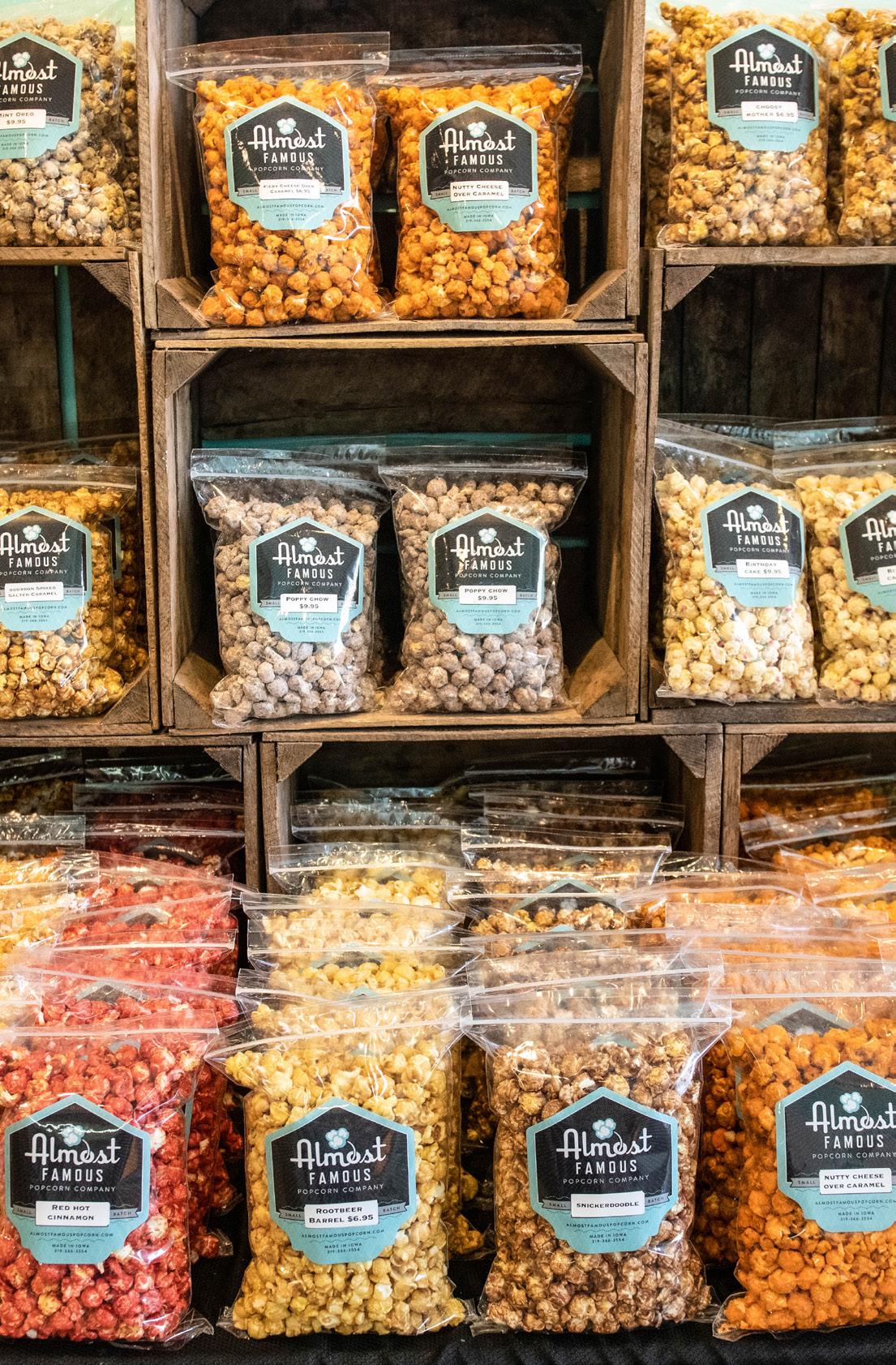
Eggs are a nutritional powerhouse, with newly recognized benefits for cognitive health.
5 EDITOR’S NOTE: 730 DAYS OF FOOD & FARMING
6 FAMILY TABLE: SAVORY SANDWICH SPECIAL
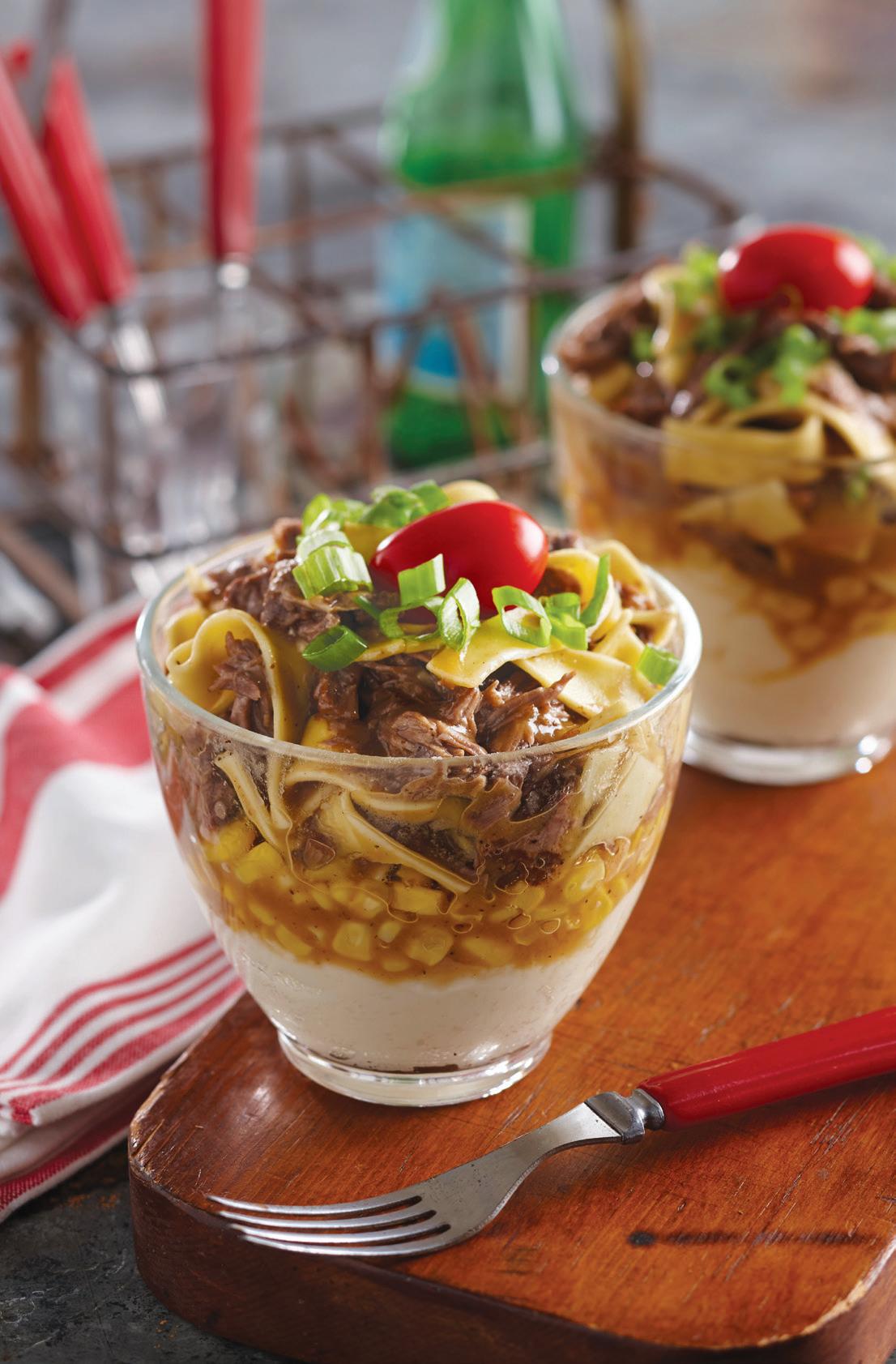
9 WELLNESS TIPS: KEEP MOVING THIS WINTER
10
POINT OF INTEREST: JESTER PARK
44
AISLE INSIGHTS: NO ONE'S PERFECT
Ray Gaesser is a southwest Iowa farmer dedicated to using cover crops to protect soil and water quality.
ON THE COVER:
Sam Berry explores trails while cross-country skiing at Jester Park near Granger.
BROUGHT TO YOU BY THE IOWA FOOD & FAMILY PROJECT
EDITOR
KELLY VISSER
PHOTO EDITOR
JOSEPH L. MURPHY
CREATIVE
ASHTON BOLES
WRITERS
AARON PUTZE, APR
LAUREN HOUSKA
ANN THELEN
Thelen Public Relations
CRISTEN CLARK
Food & Swine
HALEY BANWART
Farm Roots & Chore Boots
DARCY DOUGHERTY MAULSBY
Darcy Maulsby & Co.
FOUNDERS
Iowa Soybean Association
Iowa Pork Producers Association
Iowa Beef Industry Council
Midwest Dairy
Iowa Corn Growers Association
Iowa Poultry Association
Iowa Egg Council
Iowa Turkey Federation
The Soyfoods Council
SUPPORTERS
Anderson Erickson Dairy Cargill
Cookies Food Products
Corteva Agriscience
Earl May Nursery & Garden Center
Farm Credit Services of America
Heart of America Group
Hy-Vee
Iowa Grocery Industry Association
Iowa Machine Shed Restaurant
Iowa Select Farms
Iowa State Fair
Jethro’s BBQ
Key Cooperative
Latham Hi-Tech Seeds
Live Healthy Iowa
MercyOne
Subway
REQUEST YOUR MAILED SUBSCRIPTION AT IOWAFOODANDFAMILY.COM/MAGAZINE/SUBSCRIBE
Thank you to the Iowa Soybean Association, Iowa Pork Producers Association, Iowa Beef Industry Council, Midwest Dairy, Iowa Corn Growers Association, Iowa Egg Council, Iowa Turkey Federation, Farm Credit Services of America, Cargill, Latham Hi-Tech Seeds, Corteva Agriscience and Key Cooperative for the financial investment that makes this publication possible.
Fresh Pickings is published four times a year by: Iowa Soybean Association, 1255 SW Prairie Trail Parkway, Ankeny, Iowa 50023
For advertising information, please contact kvisser@iasoybeans.com.
Advertising space reservations must be made through the above contact information. In consideration of the acceptance of the advertisement, the agency and advertiser must, in respect of the contents of the advertisement, indemnify and save the publisher harmless against any expense arising from claims or actions against the publisher because of the publication of the content of the advertisement.
Comments: iowafoodandfamily.com/magazine/feedback

I’m thankful for these farmers who have welcomed me into their homes, patiently answered my never-ending stream of questions and addressed my misconceptions of the food system. The more I’ve learned, the more confident I feel at the grocery store and the prouder I feel about our state’s leadership in growing and raising food.
And most importantly, I’m thankful that I can share my perspective with readers like you.
This winter marks my second year with the Iowa Food & Family Project (Iowa FFP). And while this job pushes me out of my comfort zone every single day, I’m thankful for the past two years of learning about modern agriculture.
It’s been 730 humbling days of asking questions, piecing together the food chain in a way that is meaningful for consumers like me – a born and raised ‘city girl.’ With a majority of people now three generations removed from the farm, these experiences have taught me that we can all learn from today’s farmers.
Surprisingly enough, words like farrow, ration, cover crops, heifer, bushel and water quality are now a part of my daily vocabulary! What I’ve learned is that these words all have one thing in common. It’s the heartfelt passion of every farmer who brings these terms to life in a meaningful way for consumers like you and me.
Each year, Iowa FFP conducts a Consumer Pulse Survey. We survey more than 600 Iowans who are the primary grocery shoppers in their household to get feedback on food purchasing habits and attitudes toward agriculture. This group’s demographics closely represent our state’s population.

In this year’s survey, 78% of respondents are satisfied with Iowa agriculture; 56% think about how food is grown and raised; and 83% find front-of-package food marketing misleading. You can find a full summary of results on our website.
These survey findings, along with your direct feedback throughout the year, helps guide Iowa FFP’s approach to events, partnerships and editorial throughout the year.

And selfishly, your feedback will help guide my next 365 days of learning and exploring Iowa’s countryside. I can’t wait to continue sharing what I learn with you.
Enjoy the issue,
WE WANT TO HEAR WHAT YOU THINK ABOUT FRESH PICKINGS ! SHARE YOUR THOUGHTS AT iowafoodandfamily.com/magazine/feedback
Winter is a time to get cozy and enjoy comforting foods with family. Most people enjoy a piping hot bowl of soup or stew to warm from within, but it’s nice to shake things up with new recipe ideas.

A “9x13 Sandwich Special” has a special place on my weekly menu plan. The idea is a little out of the box, but assembling sandwiches in a 9x13 pan then baking once you’re ready to serve is perfect for family dinners on cold winter nights.
In this recipe, I turned an Iowa State Fair favorite into a “9x13 Sandwich Special.” Italian Grinder Sandwiches are mildly spicy, meaty sandwiches that feature a blend of Italian pork sausage and beef, pizza sauce and melty mozzarella cheese enveloped by a sturdy brat bun and baked to golden perfection. The recipe makes six large sandwiches, but my family usually eats half of a sandwich each so there are plenty of leftovers.
When assembling any baked sandwich ahead of time, I recommend spreading a small amount of butter on each side of the bun. This simple step prevents the filling ingredients from making the buns soggy while they refrigerate prior to baking.
The recipe encourages the use of brat buns so they can keep their integrity when filled. If you want to go above and beyond the recipe instructions for
a boost of flavor and texture, you can partially broil the buns in the oven, cut side up with a bit of butter and a small sprinkling of garlic salt.
If you’re taking the baked sandwiches on the go, be sure to wrap hot or warm sandwiches in aluminum foil and store in a thermal lunch bag. For a homemade hot pack, I heat a clean damp dish towel in the microwave for 45 to 60 seconds and place the cloth into a zip top baggie. The best part of a “9x13 Sandwich Special” concept is that it is easily customizable.
Do you have an abundance of leftover pulled pork? Fill the brat buns with pulled pork, drizzle on 2 teaspoons of Italian dressing and a pile of sautéed onions and peppers. Top with freshly grated mozzarella cheese for a different twist!
To create a Cuban version of this sandwich, spread mustard on one side of the bun, then stack roasted pork, ham and Swiss cheese inside along with slices of pickles and bake. I prefer to add cold pickles after baking the Cuban sandwiches, instead of baking them inside the sandwich.
And with any version of these baked sandwiches, grate your own cheese off the block for an Instagram-worthy cheese pull. Freshly grated cheese melts so nicely!
• ½ yellow onion, chopped finely
• ½ red bell pepper, chopped finely
• 4 garlic cloves, minced
• 1 pound ground beef
• 1 pound hot Italian sausage
• 2 teaspoons pizza seasoning
• 1 can (15 ounces) pizza sauce
• 1 pound mozzarella cheese, grated
• 6 sturdy brat or hoagie buns
Preheat oven to 450 degrees F.
In a large frying pan, sauté onions, red peppers and garlic for one minute. Add ground beef, Italian sausage and pizza seasoning to the frying pan, cook until browned. Remove from heat, set aside.
Line a lightly greased 9x13-inch pan with six sturdy brat or hoagie buns (four across and two on the side), sliced lengthwise and slightly opened.
Add a scant cup of the meat
mixture to the inside of each bun. Layer meat-filled buns with ¼ cup pizza sauce and ½ cup mozzarella cheese to cover all the sauce, meat and edges of buns.
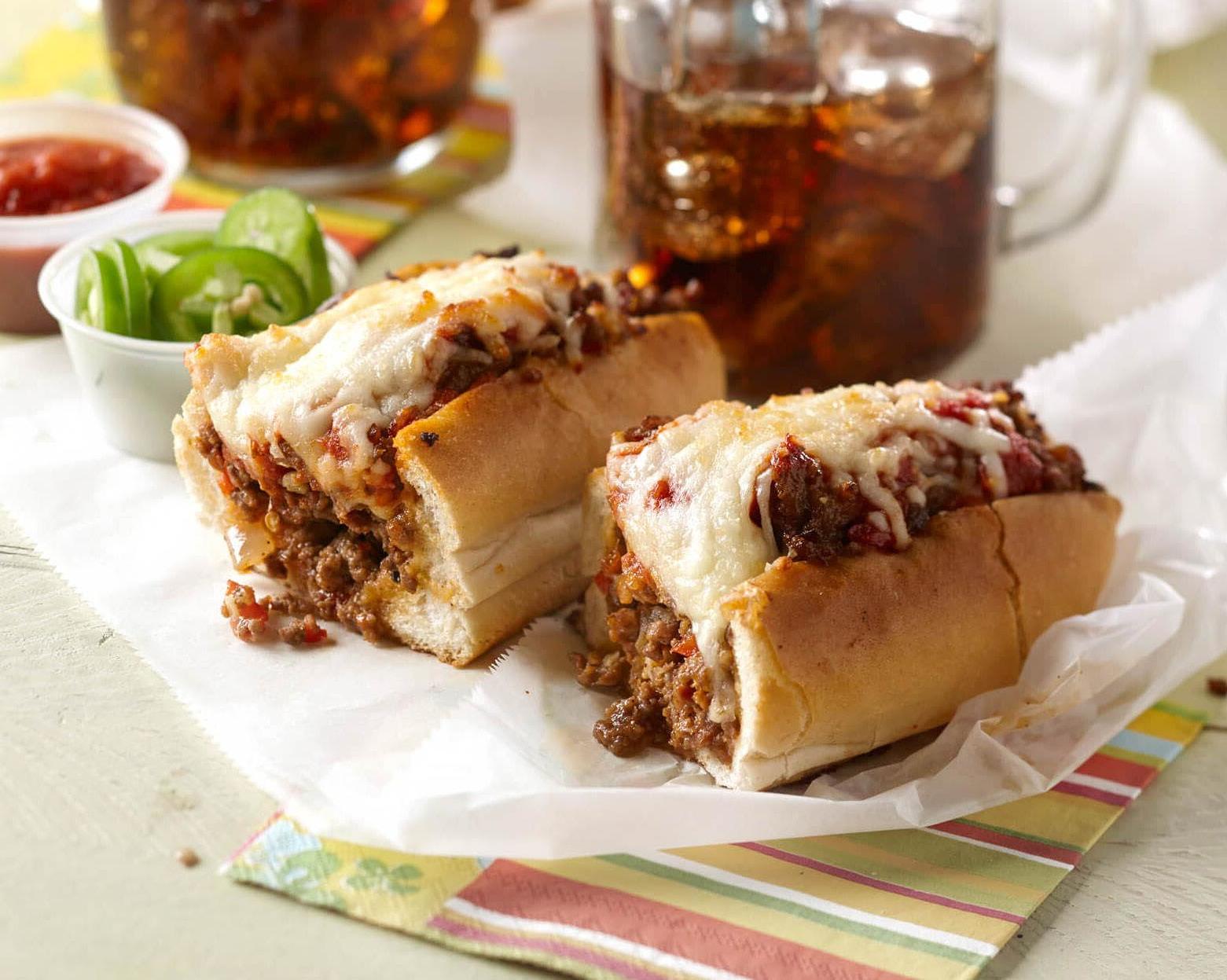
Bake at 450 degrees F for 12 to 15 minutes until cheese is melted and slightly browned. Remove from oven and serve warm.
Nutrition per serving: 982 Calories, 57.5g Total Fat, 152.0mg Cholesterol, 1,827.3mg Sodium, 61.7g Carbohydrate, 3.6g Dietary Fiber, 51.9g Protein
Servings: 6 sandwiches

EMBRACE THE COLD WEATHER WITH THESE FOUR WINTERTIME EXERCISE IDEAS.
By Kelly VisserDon’t let your healthy habits hibernate this winter! With a little creativity and motivation, you can embrace the early sunsets and freezing temperatures to keep moving all season long.
No matter the time of year, experts recommend adults get 150 minutes of moderate physical activity every week for basic health benefits. This can be broken up to 20 minutes a day, or three 50-minute workouts. It’s recommended that kids get 60 minutes of physical activity each day.
The team at Live Healthy Iowa shares four ideas on how to reach recommended levels of physical activity during cold winter months.
1. BUNDLE UP AND BRAVE THE COLD!
Simply getting outside to walk is a great way to rack up exercise minutes. You can opt for a walk around your neighborhood, along one of Iowa’s many trails or in your favorite state park. If it’s icy or an unsafe temperature, stick with indoor activities.
2. EMBRACE WINTERTIME-ONLY ACTIVITIES. Grab your sled, skis, skates and shovel to enjoy physical activities you can only do in the wintertime. Visit an ice skating rink or make a few trips up and down a sledding hill for a fun way to keep the whole family moving. Shoveling is another way to get your heart rate up in the wintertime. If you look at it as exercise, it won’t even feel like a chore!
3. TAKE ADVANTAGE OF FITNESS CENTER SPECIALS OR TRIALS. While you don’t need a gym or fitness center to stay active, many have promotions going on in the winter. Consider seeing what specials or trial classes the YMCA, fitness clubs, spin studios, yoga studios or local community education programs have. You just may find your new favorite type of workout!
4. HIIT THE BREAKS. You can incorporate high-intensity interval training (HIIT) into your downtime throughout the day. These activities should be 30 seconds of work — jumping jacks, wall squats, lunges, high knees, burpees, push-ups — then 60 seconds of rest. HIIT workouts produce many of the same health benefits as other forms of exercise in shorter amounts of time.
JESTER PARK OFFERS ENDLESS OPPORTUNITIES TO LEARN, PLAY AND EXPLORE THIS WINTER.
 By Haley Banwart / Photos by Joseph L. Murphy
By Haley Banwart / Photos by Joseph L. Murphy
Ah, the great outdoors. Fresh air, stunning views and an escape from the everyday hustle and bustle. It’s a calling residents and visitors in the Des Moines metro area can fully experience at Jester Park, one of central Iowa’s oldest and most popular outdoor playgrounds.

Located along the western shore of Saylorville Lake, the park consists of 1,700 acres of glacially formed landscape including woodlands, wetlands and reconstructed native prairie. While the park has been open to the public since 1958, funds raised through the passage of the 2012 Polk County Water and Land Legacy Bond referendum have increased access and visibility to park activities.
Today, two permanent facilities, the Jester Park Nature Center and the Outdoor Recreation and Wellness Center, offer endless opportunities for visitors to learn, play and explore.
“Our vision was to create a gateway experience that would inspire Iowans to get back to nature and expose them to different types of outdoor recreation,” says Kami Rankin, Polk County Conservation community relations coordinator. “Thanks to public and private contributions, that vision was brought to life.”
Since the grand opening of the new facilities in August 2018, the park has attracted close to 1 million visitors and nearly doubled public programming.
The Jester Park Nature Center invites visitors of all ages to engage in outdoor activities, participate in park programming and learn about Iowa’s natural heritage.
The center features educational exhibits, art galleries, meeting
rooms and a peaceful viewing deck complete with spotting scopes.
Adjacent from the Jester Park Nature Center is the Outdoor Recreation and Wellness Center. It was created to teach visitors about outdoor recreation and equip them for their next adventure.
Inside, park-goers can try their hand at archery or target shooting, gear up for a day of snowshoeing or cross-country skiing, or test their strength and agility in the Petra Alward Bouldering Room, Jester Park’s newest recreational feature.
Jester Park offers a wide range of wintertime activities for families to enjoy.
“Winter is a wonderful time to go on a hike, observe wildlife and enjoy the quiet and stillness of the season,” says Rankin.
The park has a variety of programs, including ice fishing clinics, sleigh rides and riding lessons at the equestrian center, a live bison and elk herd educational plaza, and volunteer opportunities. Plus, 5 miles of trails for cross-country skiers.


Four heated rental cabins furnished with modern amenities are also available for visitors looking to reserve a relaxing weekend getaway. An intentional lack of television and Wi-Fi allow guests to completely unplug and unwind.
“One thing I think often surprises park visitors is how refreshing it is to find yourself completely immersed in nature,” says Rankin. “As Iowans, we have a long-standing tradition of sharing a respect for the land. Through education, conservation and recreation, we gain a deeper understanding of our natural resources and become better stewards.”


Nothing is quite as memorable as a scent. Some have the power to transport you to a cherished moment in time.
The savory aromas wafting from grandma’s kitchen. The comforting fragrance of grandpa’s aftershave. The first crisp inhale after a freshly fallen blanket of snow.
For Michelle Myers, happiness smells like her family’s century farm just south of Atlantic where she and her husband, Steve, grow soybeans, corn and alfalfa and raise cattle. The happiness they've found there translates into a love for the land.

“We take a lot of pride in being good stewards of the land,” Michelle says. “We do everything we can to leave it better for the next generation who will farm it.”
Both Michelle and her husband also have full-time jobs in the agricultural industry. Between farming and full-time employment, there’s not a lot of free time. But over the last three years, she has used any free moments to cultivate her handmade candle business, Dirt Road Candle Co.
Each hand-poured candle is formulated and designed by Michelle and features an ingredient made from a crop grown right on their farm –soybeans.
“It is so important to honor my roots and way of life by using a byproduct of the crop we raise on our farm,” she says. “Soy wax, which is made from soybean oil, performs better than other candle waxes, plus it’s clean burning and renewable.”
Choosing waxes, wicks and scents might seem simple to the untrained eye – or nose! But just like farming, there is a science to making quality candles. Wicks must be the right size and strength, and fragrances must be mixed with the right ratio of soy.
Through trial and error, Michelle says she has perfected most of the logistics of making candles.
“I also watched people who had brands or were creating things that I admired,” she says. “I wasn’t afraid to ask people for help or constructive criticism.”
To continue growing the business, she knew she needed to differentiate herself from other candlemakers. Drawing from her memories and passion for farming and rural life, Michelle creates scents that are distinctively Iowan.

Will’s Cabin: In remembrance of Michelle’s cousin, this scent is an embodiment of the woodsy haze of a bonfire reaching for the night sky.
Spritz Cookie Tradition: Inspired by her grandmother’s recipe, this fragrance blends the aromas of butter and sugar with a strong punch of almond.
Iowa Barn Door: This scent, modeled after musky wood combined with the smell of freshly cut hay, takes Michelle to her favorite place on their farm – the barn.
Iowa Nice: A delightful, earthy tone and woodsy base with a touch of sweetness to celebrate the people who are Iowa Nice!
“Rural Iowa will forever have my heart,” she says. “It’s where I go to fill my proverbial cup and find most of my creative ideas.”
After harvest, soybeans are cleaned, cracked, de-hulled and rolled into flakes. The oil is extracted from the flakes and hydrogenated, a process that changes the melting point of the oil, allowing it to remain solid at room temperature.
 Soy wax is poured by hand to make each candle.
Michelle Myers, Atlantic
Soy wax is poured by hand to make each candle.
Michelle Myers, Atlantic

As the business caught on and her online audience grew, Michelle noticed customers had an interest in learning about her family’s farm. Alongside beautiful photos of the products, her audience now gets a behind-the-scenes look at life on the farm.
“When we were combining soybeans last fall, my 8-year-old niece, who lives in the city, asked me if these were the soybeans that end up in my candles,” Michelle explains. “I was so proud of her for understanding and connecting the dots. I hope that I’m helping my audience connect them, too.”

While it was intimidating to open their
farm to the eyes of the public, Michelle says transparency and authenticity are a top priority and a key part of why Dirt Road Candle Co. has flourished.

“I’ve been so surprised that people who have never been exposed to farming before will reach out to me,” she shares. “They’ll tell me they showed a video of us feeding our cows or combining soybeans to their kids who love it or have questions.”
Michelle plans to continue to cultivate this online community and share her family’s farm story.
“People are truly interested in what we are doing and why we do it,” she says.
“I absolutely love that.” Fill
From small businesses like Dirt Road Candle Co. to large manufacturing companies, soy is found almost everywhere. That’s because more industries are realizing how soy can improve products as an alternative for petrochemicals in products, such as adhesives, rubbers and plastics. It’s versatile, affordable and environmentally friendly. Visit SOYNEWUSES.ORG to learn more about soy in everyday products.
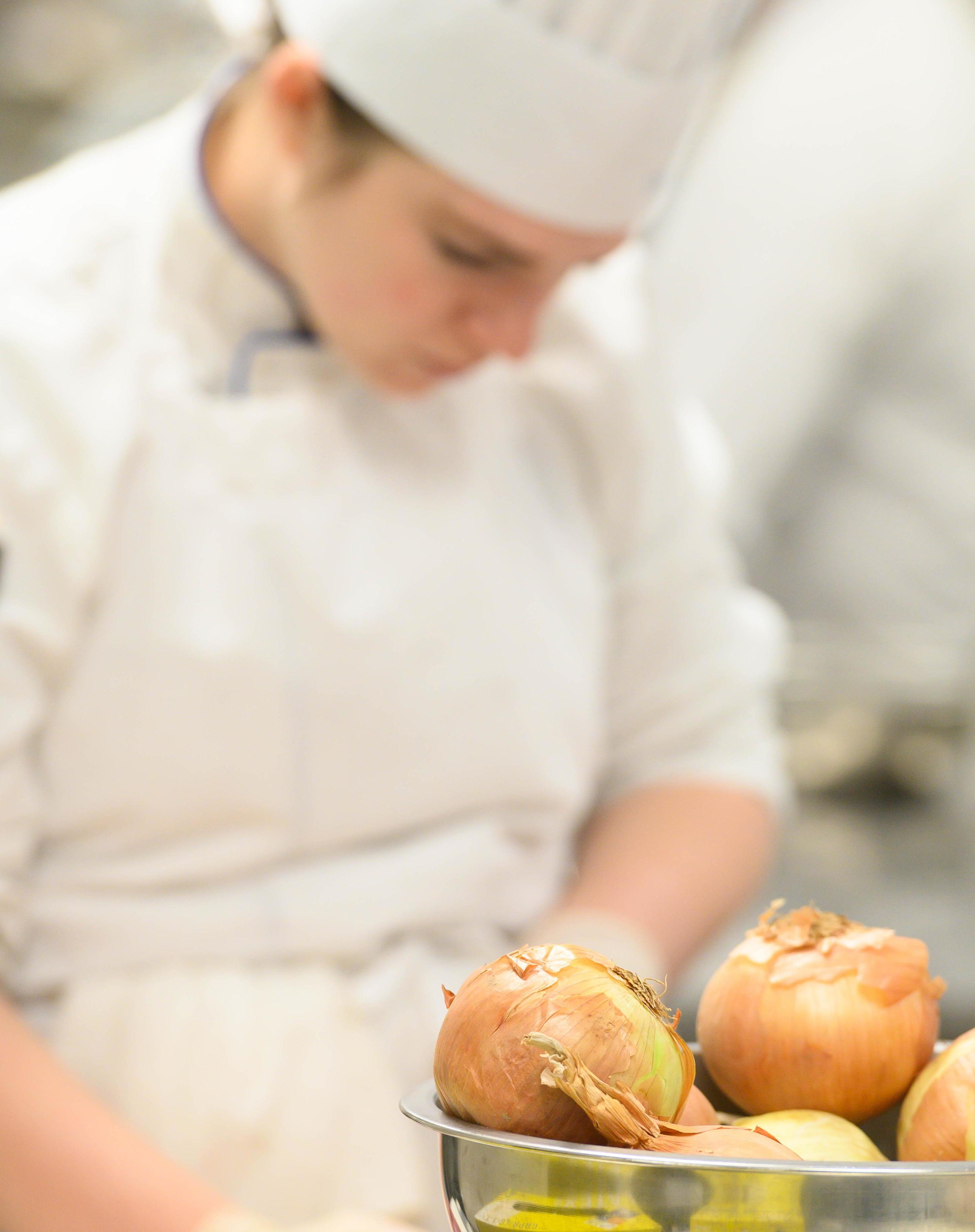
In French, the world ici means “here.” It’s fitting that in 2005, the Des Moines Area Community College (DMACC) changed the name of its Culinary Arts Program to the Iowa Culinary Institute®, with the acronym ICI®. It’s here where the philosophy is: If you can dream it, you can achieve it. It’s here where the flair, art and mastery of food come alive. And it’s here where the only French Chef Exchange at a community college in the country finds its home.
Since its founding in 1975, ICI has gained world-class prominence, primarily due to the vision of the program's founder, Executive Chef Robert Anderson, a graduate of the prestigious Culinary Institute of America. Thanks to Anderson’s


43-year career of helping students become passionate chefs, the two-year program that began with three students has elevated into a culinary masterpiece with an annual enrollment of 225 students.
The cornerstone of ingenuity at ICI is the annual French Chef Exchange, which is offered as part of the program’s two-year, fivesemester program.
This year, ICI is celebrating its 35th year of the collaboration with France, which originated at the suggestion of DMACC’s then-adjunct French Professor Maura Nelson. Anderson brought the idea to fruition by welcoming French chefs from Des Moines’
newly recognized sister city – SaintÉtienne, France. With creativity, design and a sense of cooperation being the dynamic forces of SaintÉtienne’s culture, it was a recipe for building unparalleled success at ICI.
Every January, two chefs from L’Association des Cuisiniers de la Loire come to ICI for two weeks – demonstrating and teaching techniques of classical French cuisine, explains John Andres, director of ICI. A translator facilitates communication
between the chefs, instructors and students. The guest chefs also plan the menu for the French dinners, where students gain hands-on experience preparing every aspect of the five- to seven-course meal for approximately 120 people.
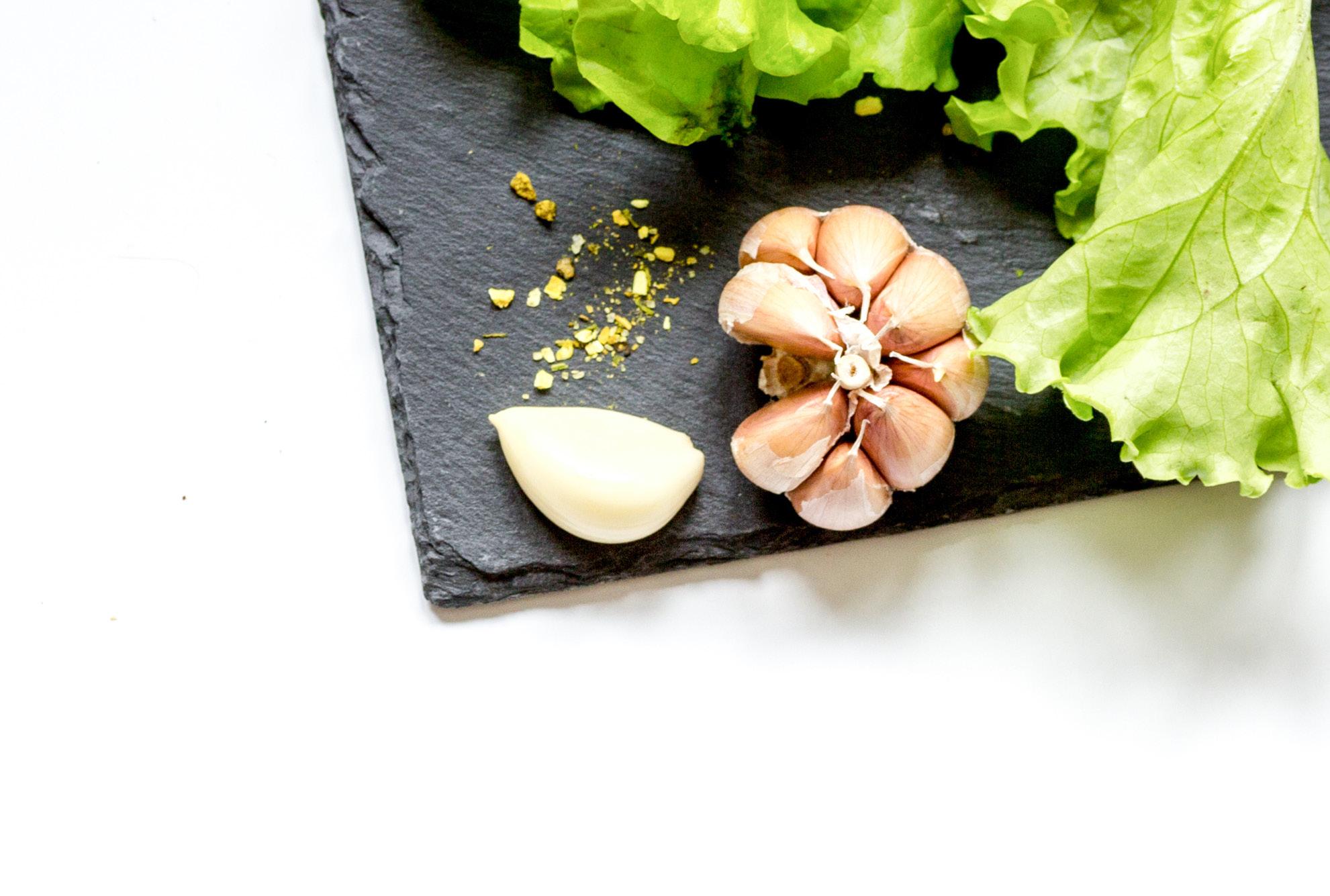
This year, to commemorate the milestone anniversary, 19 chefs from France will work with students for two weeks from Jan. 20 to Feb. 2 to prepare for the French Dinner Exchange. This event is the crown jewel of the hugely popular ICI International Gourmet Dinner Series.
These dinners introduce culinary students to ethnic ingredients, spices and products while designing meals for the American palate. They are elegant evenings of candlelight, soft live music and gourmet food paired with fine wines.
In the recent fall dinner series, patrons experienced meals focused on Caribbean, Polynesian, Italian and Himalayan cultures. The themed gourmet dinners are open
to the public at a typical cost of $120 per person and by reservation only.


“People believe in this program and appreciate what it has done for the restaurant scene in Iowa because many graduates stay here,” Andres says. “It’s a wonderful thing for students to have such strong support. We wouldn’t be able to hold gourmet dinners and have a scholarship program to France without the generous support of our donors.”
Every May, eight ICI graduates earn a spot in the highly acclaimed and life-changing scholarship program to Europe. Named the French Chef Exchange externship and led by Nelson, the first two weeks of the program are spent visiting regions of France and often other

“PEOPLE BELIEVE IN THIS PROGRAM AND APPRECIATE WHAT IT HAS DONE FOR THE RESTAURANT SCENE IN IOWA.”
— John AndresAustin Bailey, a chef instructor, teaches a first-year class at the Iowa Culinary Institute. During the first year of the program, students learn food and wine service, and core subjects like math. The math curriculum is 95% geared toward culinary criteria.
food-rich places in Europe, such as Spain, Greece and Italy. Participants visit openair food markets, experience food and wine tastings, and attend a cooking class at Le Cordon Bleu. The final two weeks are spent in Saint-Ètienne, where the graduates serve individual culinary apprenticeships in restaurants of master chefs from the Loire Association.


For more than two decades, Jim and Allison Fleming have been active supporters of ICI. Allison was introduced to the program 23 years ago when she attended a 12 Appetizers of Christmas event at the school. Since then, she has been an energetic advocate. From leading ICI’s primary fundraising gala to traveling a dozen times to France with the externship, the Flemings know how valuable this program is to Iowa.
“When the graduates return, many are employed at restaurants in Iowa,” Allison says. “They share the incredible French cooking techniques they have
learned. As a result, it has tremendously elevated the culinary scene in Iowa.”

Rebekah Kohl is a graduate of the program and a former participant in the French Chef Exchange externship. She loved it so much, she applied for a visa and worked in France for eight months. She returned to Iowa and is an adjunct professor at ICI, where she transfers her knowledge and expertise to students.
“The experience in France was outstanding,” Kohl says.
“I visited multiple Michelin restaurants from classically French to nouveau-style restaurants, where they modify cooking techniques to enhance the dining experience.”
Today, her passion is using those experiences to help students hone their skills.
“It’s gratifying when a student masters a concept that requires many techniques to come together. It can be making an over-easy egg to perfection by flipping it in the pan without any utensils. It may sound simple, but it's rather difficult,” she explains.
 Lewis Peel, a second-year student, prepares a saffron aioli sauce.
John Andres, director of the Iowa Culinary Institute, studied at the Culinary Institute of America in Hyde Park, New York. In 2012, he was named Iowa Restaurant Association Chef of the Year.
Lewis Peel, a second-year student, prepares a saffron aioli sauce.
John Andres, director of the Iowa Culinary Institute, studied at the Culinary Institute of America in Hyde Park, New York. In 2012, he was named Iowa Restaurant Association Chef of the Year.

Chef Austin Bailey is another ICI graduate whose passion for the program led him back to it. He also has a strong appreciation for agriculture. From teaching students specific knife-cutting techniques on meats to how vegetables must be cut to cook evenly, there is culinary cadence mastered among chefs.

“Today, there is so much more emphasis on the farm-to-table idea, and people are genuinely more interested in food – where it comes from and how it’s prepared,” Andres says.
In 2018, Executive Chef Robert Anderson was recognized by the Iowa House of Representatives for his leadership at the school. When accepting the award, he noted many young people want to join the farm-totable movement where fresh,
locally sourced food is the centerpiece.

The ICI received the Ordre du Mérite Agricole, France’s oldest civilian agricultural award, from the French government in 2006. The award recognizes DMACC’s promotion of French agriculture through the culinary exchange with France. The first medal recipient in 1883 was Louis Pasteur, whose pasteurization process made a significant impact on agriculture.
“I love the program on many levels. This rather elegant classroom helps students to gain skills, confidence and poise to go out and be successful," Allison says. “When I tell people outside of Iowa about our culinary program, they are stunned. It makes me proud that right here – in the heart of the Midwest – we have access to this phenomenal world-class program.”
Graduates of ICI who participated in the French Chef Exchange externship work in Iowa restaurants or in-house dining. Examples include:

• The Café, Ames
• Aunt Maude’s, Ames
• Ferinheit Pizza, Norwalk
• Fleming's Prime Steakhouse & Wine Bar, West Des Moines
• Glen Oaks Golf & Country Club, West Des Moines
• Goldie’s Ice Cream Shoppe, Prairie City
• Scenic Route Bakery, Des Moines
• Tournament Club of Iowa, Polk City
• Workiva, Ames
• Café Beudelaire, Ames
• Centro, Des Moines
• Gusto Pizza Company, Des Moines area
• Lucky Pig Pub & Grill, Ogden
• The Machine Shed, Urbandale
• MALO, Des Moines
• Tursi's Latin King, Des Moines
• Zombie Burger, Des Moines
It’s here where the philosophy is:
IF YOU CAN DREAM IT, YOU CAN ACHIEVE IT.
 Taylor Conlan, a second-year student, prepares ingredients for a meal at the Iowa Culinary Institute Bistro.
Taylor Conlan, a second-year student, prepares ingredients for a meal at the Iowa Culinary Institute Bistro.
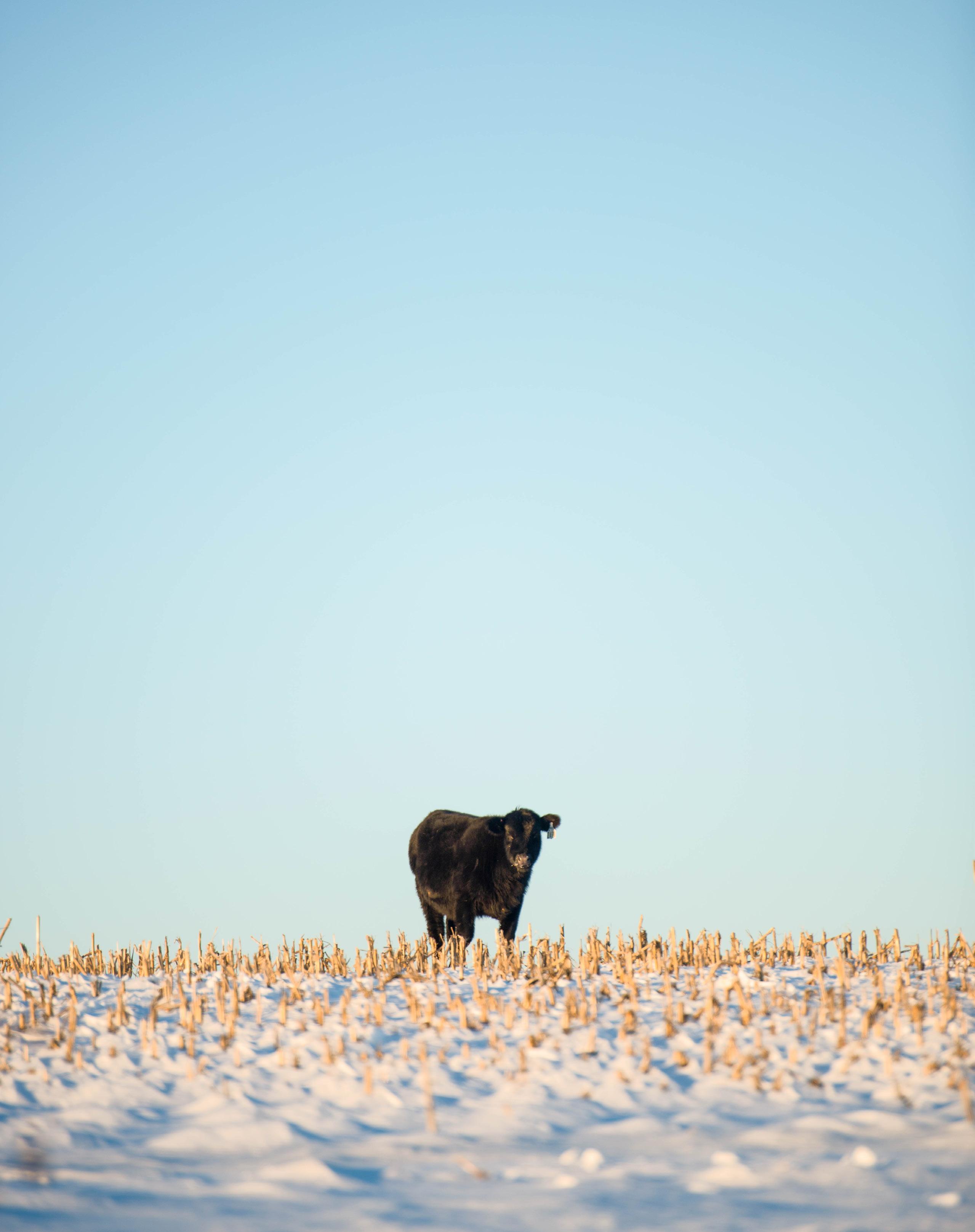
BEEF QUARTERS NEVER MISSES A BEAT.
By Ann Thelen | Photos by Joseph L. MurphyIn the middle of winter in Iowa, few people are thinking about the Iowa State Fair. Sure, there may be an occasional daydream of enjoying a Hot Beef Sundae while soaking up the sun, strolling down the Grand Concourse and meandering through the livestock buildings, face it, the fair isn't top of mind for most.
Yet, there are tireless leaders working in every season to bring the Iowa State Fair to life, constantly planning, preparing and thinking about those 11 special days in August. John Mortimer is one of those leaders. He’s a man with heart, in more ways than one.
John and Kay Mortimer are retired cattle, soybean and corn farmers, now living in Dallas County. More than three decades ago, John had a vision for serving high-quality, Iowa-raised beef during the Iowa State Fair. He
knew other commodity groups had food stands at the fair and thought Iowa’s cattle producers should do the same. In 1985, the Iowa Cattlemen’s Beef Quarters became a reality. Today – and 2 million customers later – it's not just a place to eat, it’s a landmark destination.

“We started with three menu items – sirloin steaks, hamburgers and kabobs,” John says, who at 78 years old is still the general manager of the Cattlemen’s Beef Quarters, which is operated by Beef Promotions of Iowa, Inc. It’s the role he has held since Day 1, which began the year the Iowa State Fair hit an attendance record of 668,000 people.
“Today, we serve as many people in one day as we did during the entire run of the fair 35 years ago,” he adds.
Fairgoers proudly bring their appetites for menu favorites, including Prime Rib, hamburgers and the Ranch Hand Steak Salad.
Introduced in 2006, the bestseller is the show-stopping Hot Beef Sundae. Named by fairgoers as one of the fair’s Top 5 iconic foods, it’s billed as “two scoops of hand-mashed, homestyle potatoes surrounded by slowroasted, fork-tender roast beef topped with savory beef gravy, a sprinkling of shredded cheddar cheese and finished with a sweet red cherry tomato on top.”
In total across its menu items, the Beef Quarters annually serves up approximately 28,000 pounds – or 14 tons – of certified Angus beef. Most of the beef is cooked on-site, with the delicious aromas wafting through the air and creating a sensory pathway leading fairgoers straight to the Beef Quarters.
“We have something for everyone. We offer meals to go, or a family can sit down and enjoy the fair and food experience together,” John says. Modest in nature, John is quick to point out that it’s the volunteers who make it all come together.
“Last year, we sent out 1,600 volunteer tickets; 275 of those were volunteers who served breakfast, and the rest were Iowa’s cattle producers who worked the rest of the day,” he says.
When the Beef Quarters began, 36 county cattlemen groups in Iowa each contributed $500 to get the operation started. From that initial $18,000 cumulative investment, more than $1 million has been returned to Iowa’s county cattlemen organizations to use for scholarships, youth programs, education or other activities to support the industry.
Cattle have long been the bedrock of John's life. In a serendipitous twist of fate, it’s also because of cows that he is alive.
On a cold and snowy day in February 2011, John wasn’t feeling well, and it hit him fast. As the day progressed, his wife, Kay, insisted they see a doctor. Within an hour, he was in surgery due to an aortic dissection.
“Basically, my aorta fell apart,” John says.
He was right, as an aortic dissection is defined as a situation in which the innermost layer of the aorta allows blood to flow between the layers of the aortic wall, forcing the layers apart.
When he awoke from surgery, he learned that during the procedure to repair the artery, doctors discovered a bad heart valve and replaced it with a bovine pericardial valve. With bovine being a scientific name for cows, John knew exactly what saved his life.
“It was ironic because the heart surgeon, Dr. Robert Schneider – who has since retired – had no idea what I did for a living. I guess it was fate,” John explains.

Following the surgery, Dr. Schneider was quoted as saying, “The advantage of bovine valves over mechanical ones is that barring no other complications, the patient doesn’t require blood thinners. The valves are crafted from a sheet of pericardium (heart sac) cut into leaflets and attached to a cloth and metal framework. The first models made in the 1970s and ’80s weren’t very hemodynamic (meaning they took up too much space and restricted the flow of blood). But in the 1990s, the design was improved.”
Rejection isn’t an issue since there’s no live protein. Plus, infection risks are low, basically equal to mechanical versions, though mechanical versions are more durable. The bovine valve has a typical lifespan of 15 to 20 years.
Nine years later, John’s heart is still beating strong.

Cattle have long been the bedrock of John ' s life. In a serendipitous twist of fate, it’s also because of cows that he is alive.
John’s not a man to sit still, and rarely does he miss a beat when promoting beef or supporting his alma mater, Iowa State University (ISU). In 2019, John and Kay were named Cy’s Favorite Alums by the university.

The couple has had football season tickets ever since John graduated from ISU in 1964 with a Bachelor of Science degree in Farm Operation. They’ve also held season basketball tickets for 48 years, since the opening of Hilton Coliseum. It’s been a proud
tradition of support they hope to keep alive in the Mortimer family. Their three children, Scott, Stacey and Jason, graduated from ISU and several grandchildren are students at the university.
In addition to supporting ISU athletics, John has been part of the Dallas Center Rotary Club for 50 years. He was also inducted into the Iowa Cattlemen’s Association Hall of Fame in 2002.
“I believe in giving back to a life that has given so much to me,” John says.
And as anyone who knows him can attest, he won’t miss a beat or an opportunity to do so.

• 1–3 pounds beef chuck roast
• 2 teaspoons Lawry’s seasoned salt
• 1 teaspoon cracked black pepper
• 2 bay leaves
• 4 cups beef stock
• 3 tablespoons flour

• Salt and pepper
• 4-6 cups prepared mashed potatoes
• 3 cups prepared sweet corn
• 1 pound package of egg noodles cooked to package directions, drained
• 1 bunch green onions, chopped finely
• 1 small container cherry tomatoes
Cook roast, Lawry’s seasoned salt, bay leaves and 1 ½ cups of beef stock on low in the slow cooker for 8 hours. Remove meat from pan, shred and discard excess fat. Set aside.
In 2019, John and Kay Mortimer were named Cy’s Favorite Alums. They’ve held season basketball tickets for 48 years, since the opening of Hilton Coliseum.
With remaining juices, strain 3 tablespoons fat off and place in large skillet over medium heat. Add 3 tablespoons flour and whisk together, cook for one minute. Add remaining liquids that have been strained of excess fat, whisk well. Add remaining beef stock and continue whisking while gravy comes to a simmer. Simmer gravy until thick. Season with salt and pepper to taste. Remove from heat. Fold in cooked egg noodles and shredded beef.
In serving vessels (bowls, ice cream glasses or layer in a large casserole dish and serve family style), add a generous amount of mashed potatoes, a layer of corn, a layer of beef and noodles with gravy, and a cherry tomato or two on top. Garnish with chopped green onions. Serve warm.
Nutrition per serving: 517 Calories, 13.1 Total Fat, 85.8 Cholesterol, 1,021mg Sodium, 75.6g Carbohydrate, 6.5g Fiber, 27.3g Protein Servings: 8
Source: Cristen Clark
Throughout Cedar Rapids, lions are an unmistakable symbol and nod to the city’s rich Czech history and influence.

The Cedar River. It’s the genesis of how Cedar Rapids was named – for the rapids of the river and the red cedar trees that flank the banks of the waterway. It’s what helped build Cedar Rapids into Iowa's second-largest city and establish it as a thriving grain and livestock market. In 2008, it’s also what threatened to halt the city’s vitality when the river reached a record 31.12 feet, surpassing the 500-year flood plain.

At a critical juncture for the city, leaders and residents
rose to the occasion. Their unwavering passion, dedication and commitment inspired a transformation. The billions of dollars in damage affected 561 city blocks. Since then, Cedar Rapids’ recovery has been nothing short of incredible.
“Cedar Rapids is a vibrant, up and coming city,” says Jennifer Pickar, director of communications and marketing for the city’s tourism office. “After the flood, our community came together and rebuilt better than before.
We know it’s been our chance to reinvent ourselves while uniting the pillars of our past with a future vision.”
Cedar Rapids is making it happen. The Cedar River has been embraced, and it’s inspired a natural exuberance. No matter where you turn, the food, entertainment, arts and culture scenes are exploding with energy and creativity. For first-time or frequent visitors, families or friends, foodies or nature lovers – there is something for everyone in this All-America city.
Cedar
embraces the opportunity to reinvent itself and thrive.
At the epicenter of Cedar Rapids is the grain processing industry, with Quaker Oats and General Mills serving as the steadfast icons. It’s one of the largest cities in the world for corn processing, which directly results in 4,000 jobs in the community.

Every day, 1.2 million bushels of corn are processed and 100 semitrailer trucks leave with finished products. The Cedar Rapids Quaker Oats plant is the largest cereal plant in the world, producing grocery cart favorites, such as Life, Quaker Oats oatmeal and Aunt Jemima syrup.
General Mills is the hub for Cheerios and Fruit by the Foot production. In fact, 1.3 billion feet of the popular fruit snack is made every year – that’s enough to wrap around the earth 10 times!
With 1,300 semi-truckloads of corn coming to Cedar Rapids every day, it’s no wonder 540 million gallons of clean-burning ethanol are produced every year at three ethanol plants.
Another famous icon in the heart of Cedar Rapids is Brucemore. The park-like, 26-acre estate is Iowa’s only National Trust Historic Site. Built between 1884 and 1886 by Caroline Sinclair, widow of pioneer industrialist T.M. Sinclair, it’s the site of a Queen Anne-style mansion and various gardens. The estate is available for tours and was featured by CNN to give a flavor for
the Downton Abbey lifestyle and mansions within America.

The Cedar Rapids Museum of Art possesses the world’s most extensive collection of works by Grant Wood, with a selection regularly on display. The Cedar Rapids native is one of the world’s most famous artists, mainly for painting the legendary American Gothic. Fans of the artist can see where he lived and worked when he painted some of his renowned artwork.

Throughout the city, lions are an unmistakable symbol and nod to the city’s rich Czech history and influence. When Cedar Rapids incorporated in 1856, a quarter of its 1,600 residents were Czech immigrants.
Today, the Czech Village and New Bohemia areas, just east of the Cedar River and adjacent to the downtown area, are propelling a surge of entrepreneurial vigor across the arts, entertainment and culinary scenes.
“The NewBo City Market and National Czech & Slovak Museum & Library are the two anchors and have brought so much momentum to this district.”
— Jennifer PickarBrucemoreBrucemore National Trust Historic Site Quaker Oats National Czech & Slovak Museum & Library
“The NewBo City Market and National Czech & Slovak Museum & Library are the two anchors and have brought so much momentum to this district,” Pickar says. “The concept for the market came from friends brainstorming over a glass of wine.”

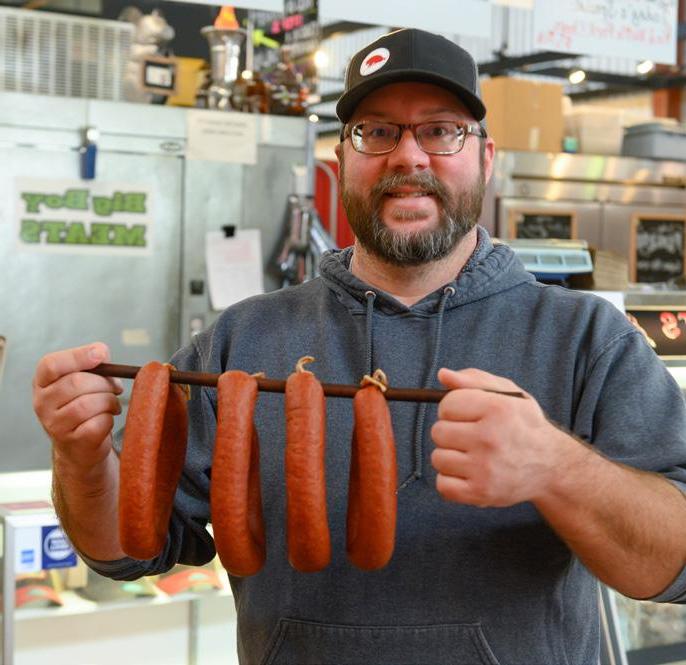


Since its opening in 2012, NewBo City Market has been the heartbeat of the New Bohemia District. As a gathering place, business incubator and event center, NewBo City Market is a diverse hub. It is home to unique food and retail business start-ups; farmers’ and artisans’ markets; and numerous community arts, entertainment and educational events.
The market acknowledges the history that is the bedrock of the area. In the late 1800s, this section was an agricultural and manufacturing hub, home to a meatpacking plant that stood for over a century. The NewBo City Market building was originally a warehouse and metalworking facility for Iowa Manufacturing and later Quality Chef Foods.
“If you want high-end fine dining, burgers and craft beer, farm-to-table meals or ethnic diversity, we have dining options to suit all of those desires,” Pickar says. “We have a lot of food diversity right in the NewBo City Market that is wonderful; then it is scattered throughout the city.”

ALMOST FAMOUS POPCORN
Almost Famous Popcorn is an example of a booming business, which also had its start in the NewBo City Market.
Bill and Robyn Rieckhoff, owners of Almost Famous Popcorn, started the business because they wanted to teach their kids – then 9 and 13 –


how to run a small business. Today, the popcorn and ice cream shop offers a place where people can come to enjoy a treat, relax and create memorable moments together.
“Since the beginning, we’ve been committed to delivering ‘Moments that Pop!’ to everyone who opens an Almost Famous bag or gift box,” Bill says. “We deliver our famous taste through premium ingredients crafted in small batches.”
In 2017, Orbitz named Almost Famous as one of the Top 5 popcorn shops in the country. Recently the company opened a 3,000-squarefoot distribution center and plans
to expand to Des Moines and Coralville. Flavors include caramel cheddar, dill pickle, monster cookie, scotch-a-roo, pizza roll, bourbonspiked salted caramel, bacon cheddar and a host of other unique, palate-enticing combinations.

The company is also the official popcorn for the University of Iowa Athletics with fans finding their delicious creations at Kinnick Stadium and Carver-Hawkeye Arena in addition to Casey’s, Fareway and Hy-Vee stores in the state.
In Czech, “Rodina” means family. With a combined 27 years of restaurant experience, Samuel and Phoebe Charles aptly named their restaurant, which opened one year ago, Rodina.
Rodina offers Midwest comfort food to its patrons. The pair focuses on sourcing food from area farmers and builds the menu around locally available ingredients. In the winter, dishes with potatoes, squash and radishes are popular due to farmers’ abilities to cellar the latefall produce, which preserves it by keeping it cool.
“We often pair these items with pork,” Samuel says. “Iowa has the best pork in the world, and we’re proud to offer it on the menu.”
They also practice the age-old tradition of family-style service.
“Our passion is ingredient-driven food. We focus on simple food, done right,” Samuel explains. “We embrace the individual ingredients, and our dishes are mainly comprised of four to five items.”
Cobble Hill Eatery & Dispensary is an upscale, fine dining restaurant and bar with an urban feel. Restaurant owners Andy and Carrie Schumacher, both University of Iowa graduates, offer patrons two enticing ways to enjoy boutiquestyle, from scratch, chef-driven menus, using local meat and vegetables.
“From a chef’s perspective, the quality of a dish begins with the highest-quality ingredients, Andy says.
“We’re proud to source many products from farmers who are
passionate about growing unique and traditional food.”
Cobble Hill’s philosophy is simple; patrons don’t have to leave Iowa to eat like being in New York City. The restaurant is named after one of the local neighborhoods in Brooklyn, New York, where the Schumachers once lived. In 2015, Andy was a James Beard Semifinalist for Best Chef of the Midwest, an award recognizing culinary excellence. Recently, the duo embarked on creating a casual dining experience modeled after Cobble Hill’s philosophy. Their new restaurant, called Caucho, serves up authentic Mexican in a trendy, modern atmosphere.
“We grateful to the Cedar Rapids region for so many styles of restaurants and for the leaders’ vision in making our community more attractive than ever before,” Andy says.
Whether it’s a visit for a day or a long weekend, Cedar Rapids offers a flawless intersection of agriculture, food, history and cultural diversity with dozens of additional destination points.
EGGS ARE A NUTRITIONAL POWERHOUSE, WITH NEWLY RECOGNIZED BENEFITS FOR COGNITIVE HEALTH.
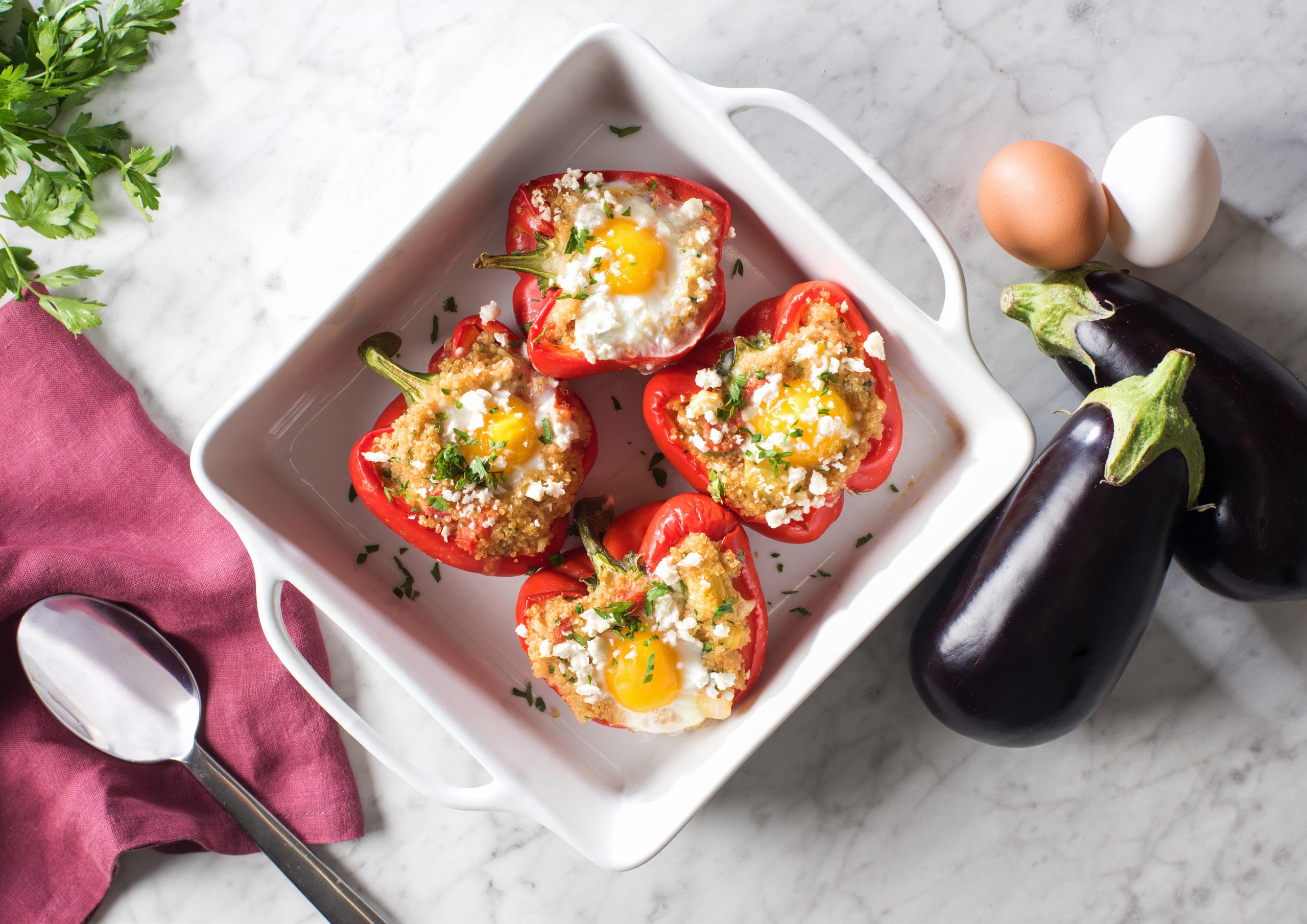 By Ann Thelen
By Ann Thelen
When it comes to health benefits, eggs are all they are cracked up to be and then some! No longer just a food to be enjoyed with toast and side of bacon for a hearty breakfast, the versatility of this mighty oval-shaped food has people enjoying eggs at every meal.
• 1 tablespoon olive oil
• ½ onion, chopped
• ¾cup eggplant, chopped
• 2 cloves garlic, minced
• ½ teaspoon each paprika and dried oregano
• ¼ teaspoon salt
• Pinch of pepper
• 1 tablespoon tomato paste
• ½ cup fresh tomatoes, chopped
• ¾cup cooked quinoa
• 2 tablespoons fresh parsley, chopped and divided
Eggs are a natural, nutrient-rich source of high-quality protein. Each egg is a good or excellent source of eight essential nutrients, such as the superstar nutrient choline, as well as lutein. Beyond promoting eye health, lutein has joined choline as a powerhouse for cognition.
• 2 large red bell peppers, halved
• 4 eggs
• ¼ cup finely crumbled fatfree feta cheese
Preheat oven to 400 degrees F. Heat oil in large skillet set over medium-high heat. Cook onion, eggplant, garlic, paprika, oregano, salt and pepper for about 5 minutes or until eggplant starts to soften. Stir in tomato paste and
cook for 1 minute. Stir in tomatoes; cook for about 5 minutes or until eggplant and tomatoes are tender.
Remove from heat and stir in quinoa and half of the parsley. Spoon quinoa and vegetable mixture evenly into red pepper halves. Arrange in greased baking dish. Cover with foil. Bake for about 20 minutes or until peppers are tender-crisp.
Remove foil. Crack one egg into each stuffed pepper, and sprinkle with feta. Bake uncovered for 10 to 12 minutes or until peppers are tender and eggs whites are set or until desired doneness. Sprinkle with remaining parsley.
Servings: 4 Source: incredibleegg.org
1
Eggs are delicious. They can be incorporated into every food group at any time of day.
2 Eggs are simple to cook. From teenagers to elderly adults, people of all ages can master the simple art of making scrambled eggs.
3 Eggs are cost-effective. On average, eggs cost 15 cents per serving. Plus, they’re everywhere, from grocery stores to farmers’ markets.
4 Eggs are filling.
With 6 grams of high-quality protein and good fat, they’re a snack that lasts.
5
Eggs are easy to eat. They are the perfect solid food to introduce to babies, and a soft option for later in life when chewing may be difficult.
One large egg is a good or excellent source of highquality protein, all in just 70 calories. High-quality proteins have all essential amino acids, which are not produced by the body and are needed for children to grow and for a body of any age to function properly. When protein is eaten, it's broken down into amino acids, which are then used to help the body with various processes, such as building muscle and regulating immune function.
The majority of an egg’s nutrient package is found in the yolk.


The white contains 60% of the egg’s highquality protein.
Key yolk nutrients:
Choline
Essential for normal functioning of all cells, but particularly important during pregnancy to support healthy brain development of the fetus.
Vitamin D
Critical for bone health and immune function. Eggs are one of the only foods that naturally contain vitamin D.
Antioxidants that are believed to reduce the risk of developing cataracts and slow the progression of age-related macular degeneration, an eye disease that develops with age.
“Compelling research continues to laud eggs as a powerhouse for brain development and cognition throughout life,” says Mickey Rubin, Ph.D., executive director of the Egg Nutrition Center.
Eggs contain choline, which is critical for brain development during pregnancy and infancy. However, the 2015-2020 Dietary Guidelines for Americans name choline as a nutrient more than 90% of Americans (including approximately 90% of pregnant women) under consume, he says.
The majority of multivitamins and prenatal supplements do not supply adequate choline. Closing the choline gap can be done with foods, such as eggs, meat and seafood. Two eggs supply nearly

• 2 firm ripe avocados, halved and pitted
• 4 eggs
• ¼ teaspoon each salt and pepper
• 1 tablespoon sriracha hot sauce

• 1 tablespoon cilantro, finely chopped
Preheat oven to 425 degrees F. Line 8-inch square baking pan with foil. Scoop out some of the pulp from avocado halves, leaving a hole big enough to fit an egg (reserve pulp for another use).
Place avocado halves in prepared pan to fit snugly in a single layer. Fold foil around avocado halves to prevent tipping.
Crack egg into each avocado half; season with salt and pepper. Bake for 12 to 15 minutes or until whites are set and eggs are cooked to desired doneness. Let stand for 5 minutes before serving.
Drizzle each egg with hot sauce and sprinkle cilantro over top.
Servings: 4
Source: incredibleegg.org
300 mg of choline, more than half the amount recommended for pregnant women.
A recent report by the American Academy of Pediatrics (AAP) states that the first 1,000 days of life, defined as pregnancy through the first 24 months of a baby’s life, are crucial days in a child’s neurodevelopment and lifelong cognitive health. Research shows that the nutrients in eggs are associated with improved cognitive performance in adults throughout all stages of life.
Rubin says the AAP report states that although all nutrients are necessary for brain growth, key nutrients that support neurodevelopment include protein; zinc; iron; choline; folate; iodine; vitamins A, D, B6, and B12; and long-chain polyunsaturated fatty
acids. The report goes on to say that failure to provide key nutrients during this critical period of brain development may result in lifelong deficits in brain function despite subsequent nutrient repletion.
“Without a doubt, eggs are the most complete food in providing these nutrients,” he adds.
Lutein, which is abundant in eggs, has long been associated with eye health, helping to protect against age-related macular degeneration and cataracts. Research has discovered lutein may also play an essential role in cognition. Similar to how lutein accumulates in the eye, it’s also present in the brain and has been associated with cognitive function in older adults and academic performance in children.

EYE: Lutein and zeaxanthin are carotenoids found in egg yolks that can support eye health.
MUSCLE: Eating 20-40 grams of high-quality protein, from foods like eggs, promotes muscle recovery following exercise. Adequate protein intake also helps active individuals preserve muscle during aging.
STOMACH: Eating a higher-protein diet can help satisfy the appetite. Eggs are a good source of high-quality protein, with 6 grams per large egg.
BONE: Eggs are a natural food source of vitamin D (41 IU, 6% of Recommended Daily Value in a large egg), a nutrient critical for bone health.
BRAIN: Eggs are an excellent source of choline — an essential nutrient critical for fetal brain development and brain function. New research shows how choline throughout life may have lasting effects on cognition and prevention of cognitive decline.
HEART: Scientific evidence demonstrates that eggs, when consumed as part of a healthy diet, do not negatively impact risk factors for heart disease. A recent review showed eating eggs is linked to a 12 percent decreased risk of stroke and is not associated with coronary heart disease.
BLOOD: Research studies have shown dietary cholesterol does not negatively impact blood cholesterol. In fact, eating eggs may increase HDL "good" cholesterol and its function.

• 2 tablespoons extra virgin olive oil
• 2 medium garlic cloves, minced
• ½ teaspoon red chili flakes
• 4 medium zucchini, spiralized into noodles
• ¼ teaspoon each salt and pepper
• 2 cups cherry tomatoes, halved
• 2 cups packed baby spinach
• 1 teaspoon lemon zest
• 1 tablespoon fresh lemon juice
• 4 large eggs
• ¼ cup shaved Parmesan cheese
• ¼ cup basil leaves, thinly sliced
Heat oil in a large, deep nonstick skillet on mediumhigh heat. Cook garlic and chili flakes for 1 minute, stirring continually, or until softened. Add zucchini noodles, salt and pepper and cook, tossing gently, for 1 to 2 minutes or until zucchini has softened. Stir tomatoes, spinach, lemon zest and juice gently into zucchini mixture until well
combined. Cook for another 1 to 2 minutes or until spinach is wilted and tomatoes are warmed through.
Meanwhile, bring 2 to 3 inches of water to boil in large saucepan or deep skillet. Adjust heat setting to keep liquid simmering gently. Break eggs, one at a time, into custard cup or saucer. Slip each egg into water holding dish close to surface. Cook eggs to a soft poach — about 3 to 5 minutes or until whites are completely set and yolks begin to thicken but are not hard. Do not stir. Lift eggs from water with slotted spoon; drain well.
Divide zucchini mixture among four dinner plates and garnish with Parmesan and basil. Top each with one poached egg. Serve immediately.
Ser vings: 4
Source: incredibleegg.org
On a ham or turkey sandwich, add an egg. Layer on spinach leaves, cucumber or tomato slices to power up the nutrient intake. New research from Purdue University shows that eggs help the body absorb nutrients found in vegetables, such as vitamin E and carotenoids (antioxidants).

Carotenoids like betacarotene and lycopene boast a host of antiinflammatory benefits for heart health. Past research has linked greater consumption of these carotenoids to lowering risks of prostate, bladder and lung cancers.
A one-pot-wonder that delights taste buds with potent spices, such as garlic, cumin and harissa. Start by sautéing onions and garlic, add spices, tomatoes or tomatillos to create a tomato-based sauce in the skillet. One at a time, crack eggs over the sauce, cover and let it steam for 5 minutes or until the desired doneness of the eggs. Pair Shakshouka with a salad or fresh fruit for a complete meal in less than 30 minutes.
For an effortless and readily available snack, make a batch of hard-boiled eggs on the stove or in an Instant Pot®. For a burst of flavor, dress up the egg with spices like chili powder, cayenne or smoked paprika. Just a dash or two transforms eggs into a Cajun- or Mexican-flavored treat. Hard-boiled eggs are also great for dipping into ranch, balsamic or sriracha sauces. Add them to a salad or for some bulk, pair eggs with rice or quinoa.
A blank food canvas, bowls can be made at home with any flavor profile. Start with a grain, such as cooked brown rice, quinoa, farro or spelt. Add fresh or sautéed vegetables, and season with Thai Chili or Asian stir-fry sauce. Top the bowl with an egg – fried, poached or hard-boiled – to scoop up additional protein!
Scrambled eggs, omelets and frittatas offer lots of variations for eggs to be the star of the show, supported with a variety of meats, cheeses and vegetables. These dishes are anytime meals that are as healthy as they are delicious. For on-the-go variations, make eggs in a mug or egg muffins. Both of these options allow families to be creative with what’s added to the egg base. It’s also a great way to use leftover proteins from a previous night’s meal, such as hamburger, chicken or pork.
Nancy Macklin, RDN, a food and nutrition professional with expertise in on-trend recipe development, shares some easy ways that people of all ages can incorporate eggs into their diet.
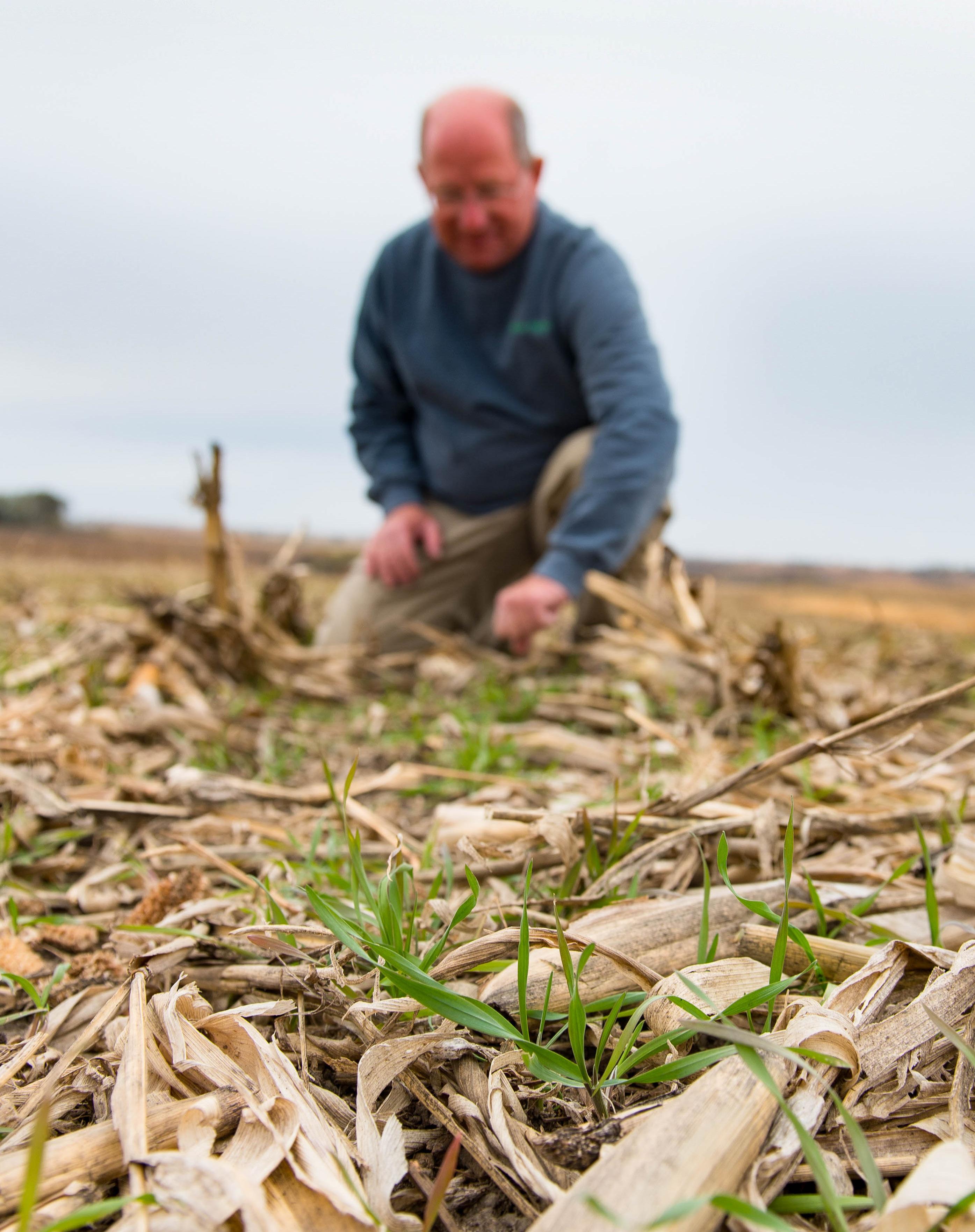
 By Darcy Dougherty Maulsby | Photos by Joseph L. Murphy
By Darcy Dougherty Maulsby | Photos by Joseph L. Murphy
If you’ve ever been in love, you know what it feels like to be captivated by exhilaration, joy and excitement. That’s how Ray Gaesser felt when he visited the Farm Progress Show in north central Iowa in 1974.
“I fell in love with Iowa and its incredible farmland,” says Gaesser, an Indiana native who farms in southwest Iowa between Lenox and Corning. “I knew this was the place for me.”
Gaesser grew up on a 160-acre farm near the small town of Santa Claus in southern Indiana.
After his father passed away, Gaesser began managing the farm while he was still a teenager. “All I ever wanted to do is farm,” he says.
As a lifelong farmer, Gaesser cherishes good soil. “One acre of
our best soil in Iowa is better than my family’s entire 160-acre farm back in Indiana,” says Gaesser, who moved to Iowa at age 25 when he and his wife, Elaine, bought a farm in 1977. “That’s why I’m passionate about protecting it.”
Since he farms in an area with gently rolling land, Gaesser has built terraces – essentially “steps” in a field that slow the flow of water and create level plains where crops can be grown – during the past 40 years to help hold soil in place. A rainstorm one day in early May 2010, however, marked a turning point in his farming career. “My son, Chris, and I were in the house, watching the sheets of rain pour over our terraces,” Gaesser explains. “It was like a cascade. I’d never seen anything like that before.”
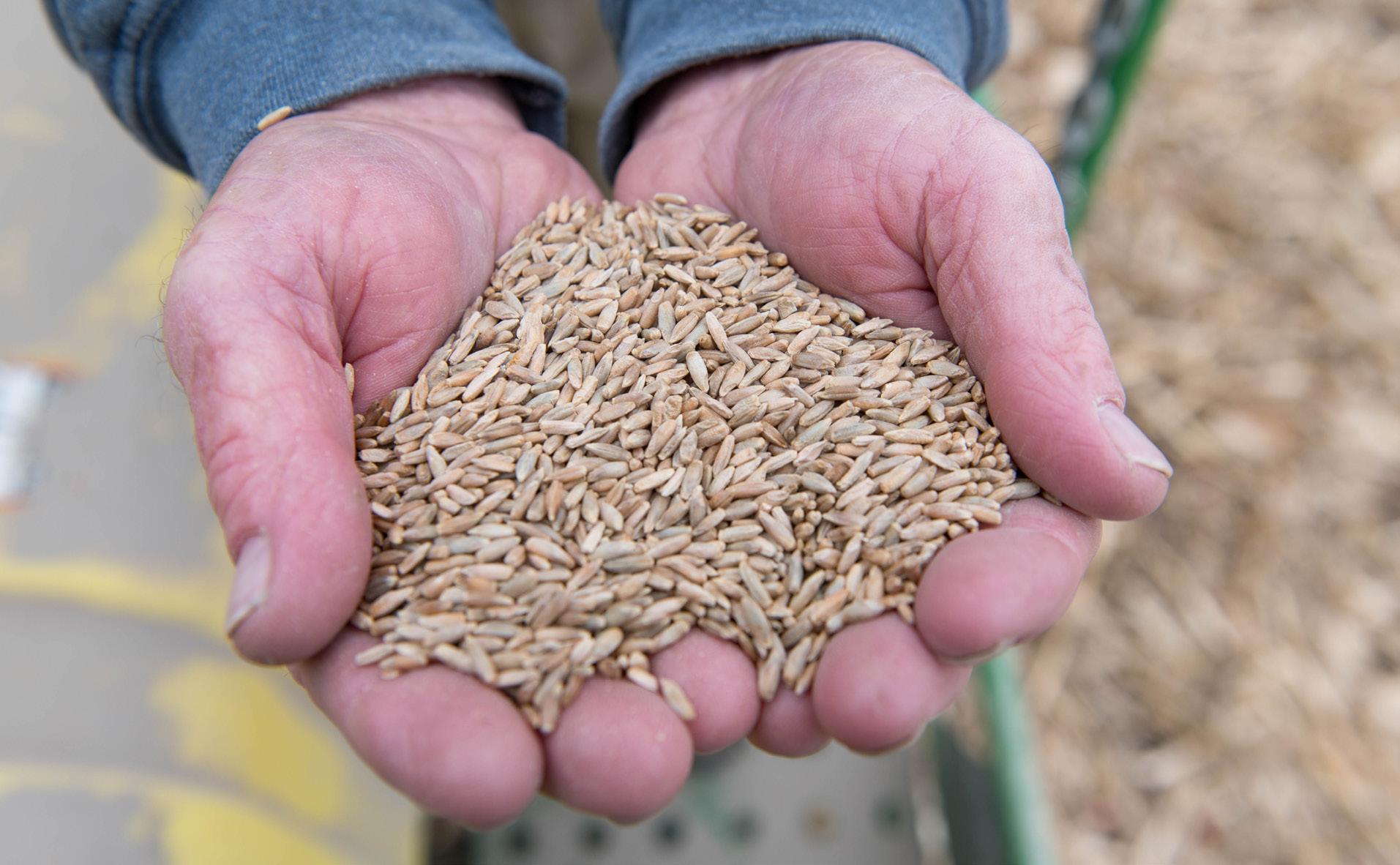
Cover crops are small grains and other plants that are seeded in the late summer or early fall to keep a living cover on the landscape, after corn and soybean crops have been harvested.
While 4 inches of rain in an hour was unusual, storms of this magnitude have become increasingly common through the years, Gaesser says. “That’s why we started planting cover crops. We want to use practices that keep the soil in place, build soil health and also protect water quality.”
Cover crops have become increasingly popular in Iowa in the past 10 years. Cover crops can include small grains and other plants that are seeded in the late summer or early fall to keep a living cover on the landscape, after corn and soybean crops have been harvested. Numerous studies have shown these plants can help protect soil and water quality, reduce chemical input costs, boost crop yields, increase forage availability for cattle and provide other benefits, according to Practical Farmers of Iowa (PFI).
Gaesser planted a couple hundred acres with cover crops in the fall of 2010. He and his son continued doubling the number of acres planted with cover crops each year. “We like using cereal rye, because it’s easy to grow and works well,” says Gaesser, who currently plants cereal rye on more than 2,000 acres of his family’s 5,400-acre farm. “We plant soybeans right into the cereal rye in the spring.”
He’s not alone. The number of cover crop acres across Iowa has increased dramatically in the past decade, soaring from fewer than 10,000 acres in 2009 to about 600,000 acres in 2016, according to PFI. More farmers continue to incorporate cover crops into their production systems. Iowa cover crop acres grew by approximately 16% in 2018, resulting in approximately 880,000 total acres, according to Iowa State University Extension and Outreach.
“In some ways, using cover crops is a return to the fundamentals of farming,” explains Roger Wolf, director of innovation and integrated solutions for the Iowa Soybean Association. “The goal is to build more resilient soil and help clean the water.”
Many Iowa communities draw their drinking water from rivers flowing through the state. The agriculture industry can directly affect the quality of Iowa’s rivers by managing the soil on farmland across the state, Wolf notes. He works with Agriculture’s Clean Water Alliance (ACWA) to create a benchmark for water quality by monitoring nitrate levels in Iowa watersheds. These areas of land
are where all water that drains off the surface collects in the same body of water, such as a stream or lake.
Water Quality Initiative (WQI) projects, which include cover crops and other conservation practices, are making a positive impact on the health of Iowa’s environment. “We’re working where the water starts, which is on the farm,” Wolf says.

In north central Iowa, Prairie Creek’s WQI project at the north end of the Boone River is one example where more conservation practices have been implemented in the past decade. Water samples indicate a decrease in nitrates in Prairie Creek from 2007 to now, according to ACWA data.
While cover crops offer many advantages, they add another layer of complexity and more costs to farming systems, from extra labor to seeding equipment to the cost of the seed itself. “You also add more risk anytime you add another crop,” Wolf says. “Success requires that farmers put more detailed management systems together.”
Gaesser is up to the challenge and is willing to embrace proven solutions. He adopted no-till farming nearly 30 years ago. It offers a way to grow crops without disturbing soil with tilling or plowing. This type of system works well for the rolling land on Gaesser’s farm. This helps reduce soil erosion and retain soil moisture, which benefits crops during dry spells.
Ray Gaesser has made conservation on his farm a priority. He continually looks for ways to help build soil health while protecting water quality.Gaesser also partners with his neighbors to use poultry and hog manure to nourish his crops. “This is the circle of life,” he says. “The corn and soybeans we raise help feed the livestock, whose manure helps fertilize the next crop.”
That circle of life also extends to Gaesser’s cover crop system, in which he grows and harvests the cover crop seeds he plants in his fields. He also sells cover crop seeds to some of his neighbors.
“Ray is a conservation leader,” Wolf says. “Not only does he use cover crops on his acres, but he has another revenue stream for his farm by selling cover crop seeds.”
Gaesser enjoys sharing his knowledge about cover crops with farmers nationwide. “I feel a responsibility to give back,” says Gaesser, who ran for Iowa Secretary of Agriculture in 2018 and has also served as president of the Iowa Soybean Association and American Soybean Association. “I remind farmers that our first responsibility is to protect the soil.”
His travels around the globe on behalf of agriculture have shown Gaesser that Iowa farmers are on the right track. He thinks back to a trip he took to China in 2013.
“We were in the northeast part of the country, where the farmers were using farming practices like we did 80 years ago. They had pretty good black soil, but they plowed up and down the hills, and the erosion was horrific,” he recalls.
Closer to home, signs of progress are evident when Gaesser considers how things used to be, compared to now. “In the 1950s and 1960s, county crews would have to use snowplows to remove soil that had blown off the fields. It’s not like that anymore. As farmers, we’re learning as we go.”
Wolf has also seen tremendous progress during his 30-year career in Iowa agriculture. “I’m bullish about the future. There’s more support than ever for conservation practices, including cover crops,” he adds.

Gaesser continues to seek opportunities to surround himself with positive people who are focused on continuous improvement, including the use of cover crops to protect Iowa’s natural resources. “Soil is precious,” he emphasizes. “Healthy soils make healthy farms, which make healthy Iowa communities today and for future generations.”
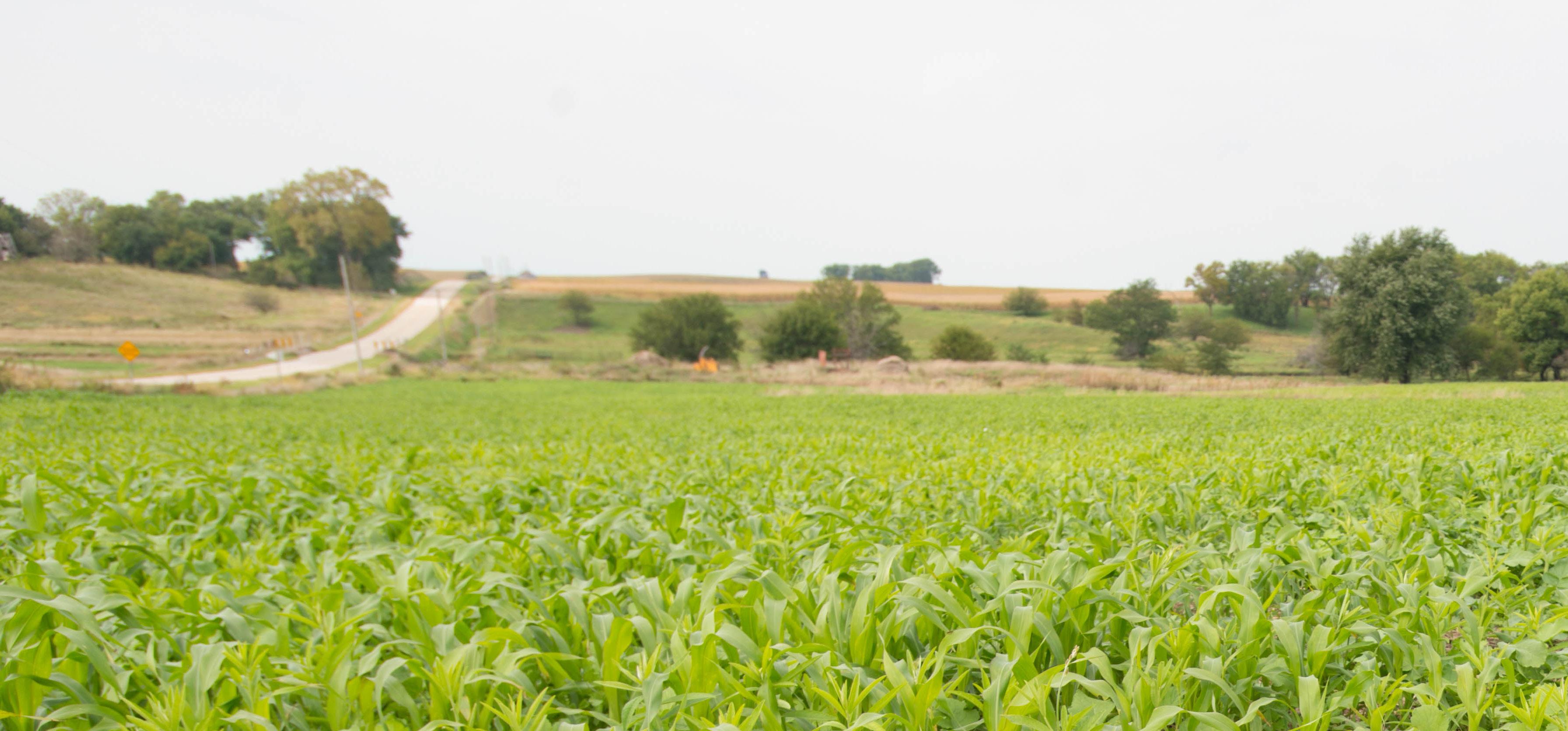
IOWA COVER CROP ACRES GREW BY APPROXIMATELY 16% IN 2018, RESULTING IN NEARLY 880,000 TOTAL ACRES.
Nonlegume cover crops, which are mainly grass species, are very useful for scavenging nutrients left over from a previous crop. They tend to have extensive root systems, and some establish rapidly and can greatly reduce erosion.
EXAMPLES:
• Winter cereal rye
• Winter triticale
• Winter wheat
• Winter barley
• Oats
• Winter ryegrass
Brassica cover crops get off to a fast start, providing rapid ground cover that protects the soil from erosion and helps suppress weeds. Some farmers consider oilseed radish to be a bio-drill, as its long taproots aerate the soil and help decrease compaction.
EXAMPLES:
• Rapeseed
• Brown mustard
• Oilseed radish
• Turnips
Legume cover crops can fix nitrogen from the atmosphere and add it to the soil to be used for the next crop. Legumes also provide other benefits, including attracting beneficial insects, helping control erosion and adding organic matter to soils.
EXAMPLES:
• Hairy vetch
• Common vetch
• Winter lentil
• Winter pea
Numerous studies have shown these plants can help protect soil and water quality, reduce chemical input costs, boost crop yields, increase forage availability for cattle and provide other benefits, according to Practical Farmers of Iowa (PFI).
Cover crops are just one way farmers are protecting Iowa’s land.

January is quickly fading. So, too, are many resolutions that accompanied the ringing in of the new year.
If you’re among those who’ve settled back into some routines or habits you resolved to ditch as the ball dropped in Times Square, don’t be discouraged. By Jan. 12, surveys find the majority of New Year’s resolutions have begun to wane for the majority of Americans. Come Feb. 1, most become a distant memory.
Goes to show we’re not perfect.
Come to think of it, neither is Whole Foods.
I was reminded of this recently when I heard the Austin, Texasbased supermarket chain was voluntarily recalling its raspberry cheesecake Italian Gelato. The reason: It contained egg not listed on the product label. The situation was discovered after the grocer noticed that other products were mistakenly packed by its supplier in containers labeled for the raspberry cheesecake creation.
As the parent of children with food allergies, I know all too well the threat an unlisted ingredient can

pose. It was also a reminder that even Whole Foods’ suppliers make mistakes.
Food recalls are serious business. And there have been notable ones over the years involving a variety of products, including beef, peanuts, eggs, lettuce, turkey, chicken and hot dogs. No product is immune, as food safety issues have arose involving such fan favorites as chocolate chip cookie batter, frozen meals and mac ‘n cheese (a staple of college students everywhere!).
If you think the number of food recalls reported annually is on the rise, you’re right. The U.S. Department of Agriculture’s Food Safety and Inspection Service and the U.S. Food and Drug Administration have reported a spike in product recalls over the past 15 years.
Undeclared allergens account for around 40% of recalls while about one-third involve bacterial contamination, including Salmonella, E. coli and Listeria monocytogenes. Another 10% can be attributed to mislabeled food.
The logical question is: why the increase?
There are about as many reasons as there are for calling it quits on a New Year’s resolution.
Food safety experts and authors cite a long list of potential culprits. The most likely, they agree, are the technological improvements that have been made in food testing over the past 20 years. The U.S. food industry spends more than $20 billion annually in testing services. That’s a lot of cash. And this amount is sure to increase as consumer wants, expectations and susceptibility to food allergens continue to evolve.
Better technology is a game-changer – for life and food safety. Enhanced methods of detection and quicker turnaround times for results translate into more and speedier
food recalls. Additional regulations, safeguards and enforcement drive improved food safety detection and surveillance. Add to that, more aggressive reporting and the 24/7 news cycle (and the fact that everyone eats) and you have the perfect recipe for greater publicity and awareness of safety issues involving food … for humans and pets!
So, should you worry about the safety of your next meal, snack or beverage? How you answer is likely as varied as the breakfast cereal options available at your favorite supermarket.
Experience tells me the things we tend to worry about most rarely occur. Now, I’ll never be confused for a doctor, but I’m inclined to think
that worry and fear pose a much greater threat to human health than what’s in your refrigerator.
Come to think of it, the increase in the number of food recalls gives me faith that our food system is functioning at a very high level. Food is often recalled voluntarily out of an abundance of caution. Trust, after all, between a brand and its consumers is paramount. Perspective matters, too. When I think of the billions of food items available for consumption annually, the number recalled seems relatively puny. Again, it’s a matter of perspective.
Now, pardon me while I take a break from writing to hit the treadmill. I have a New Year’s resolution I’m still trying to keep!
37.5% undeclared allergens
21% bacterial contamination
17% foreign material
24.5% ot her
